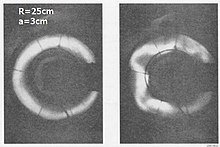Kink instability

A kink instability (also known as a kink oscillation or kink mode) is a
Kruskal–Shafranov limit[1][2][3] and is sometimes known as the Kruskal–Shafranov (kink) instability,[4][5] named after Martin David Kruskal and Vitaly Shafranov
.
The kink instability was first widely explored in fusion power machines with Z-pinch configurations in the 1950s.[6] It is one of the common magnetohydrodynamic instability modes which can develop in a pinch plasma and is sometimes referred to as the mode.[6] (The other is the mode known as the sausage instability.)
If a "kink" begins to develop in a column the
magnetic forces on the inside of the kink become larger than those on the outside, which leads to growth of the perturbation.[6][7]
As it develops at fixed areas in the plasma, kinks belong to the class of "absolute plasma instabilities", as opposed to convective processes.
References
- ISSN 1070-664X.
- ISSN 1070-664X.
- ISSN 1070-664X.
- ISBN 9781483271057.
- ISBN 9783642659805.
- ^ ISBN 9783319511771.
- ^ Plasma Dictionary Archived 2006-09-29 at the Wayback Machine


